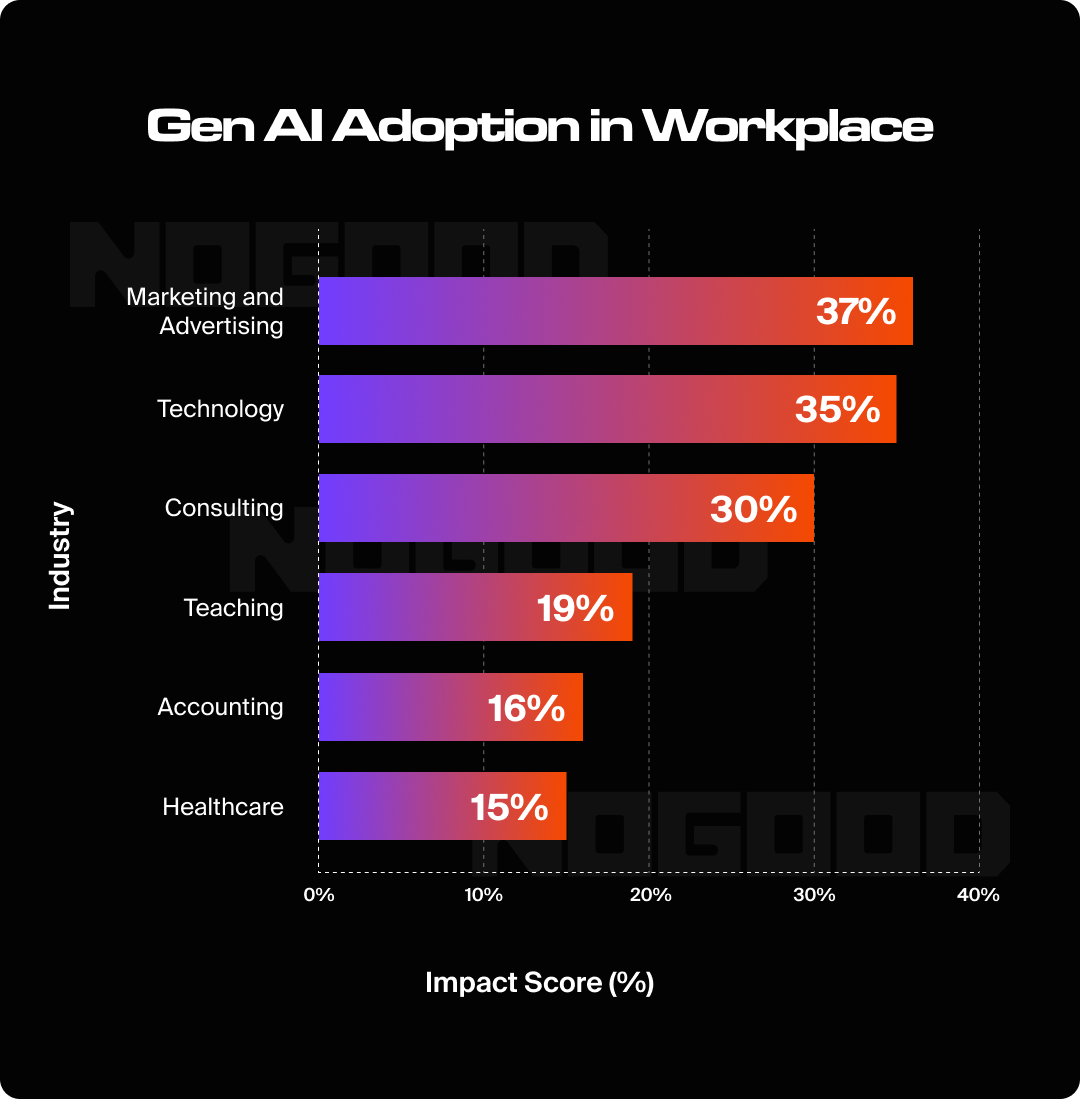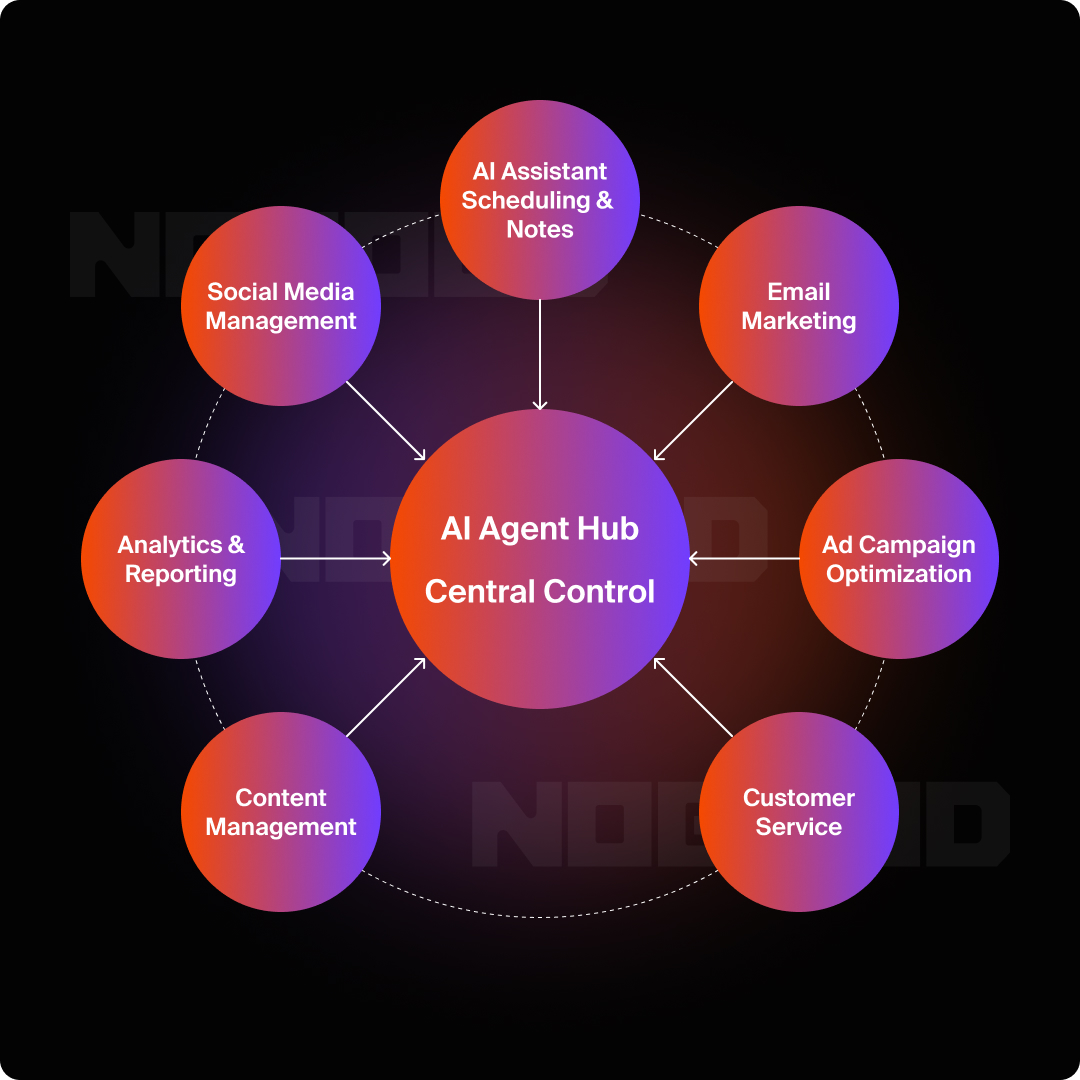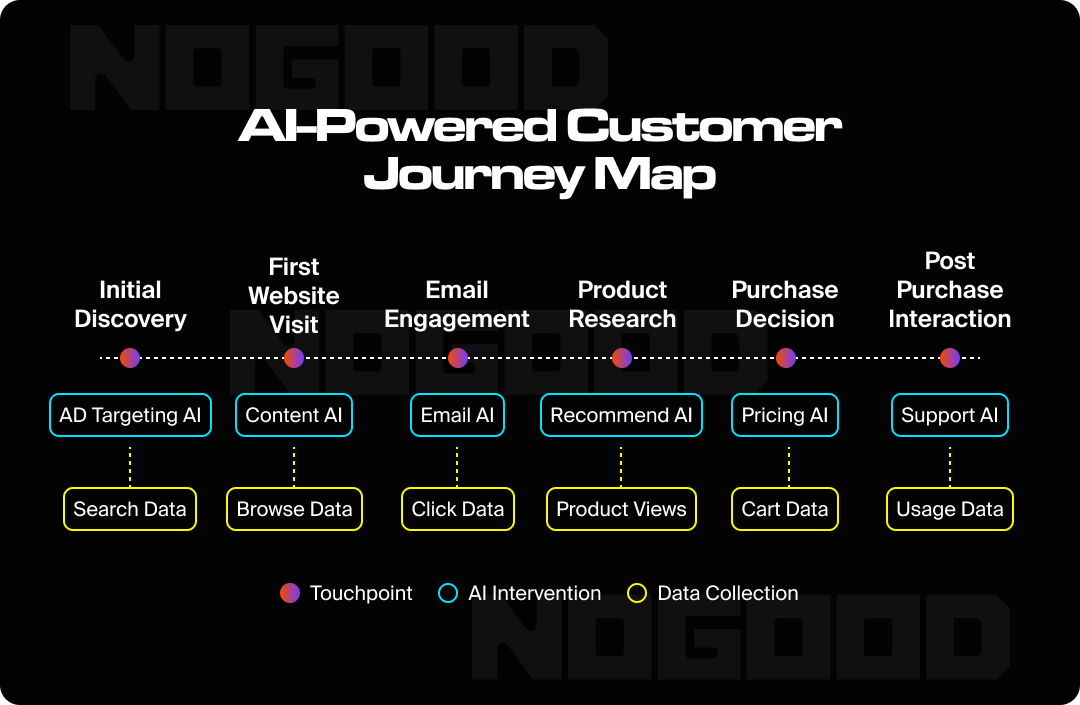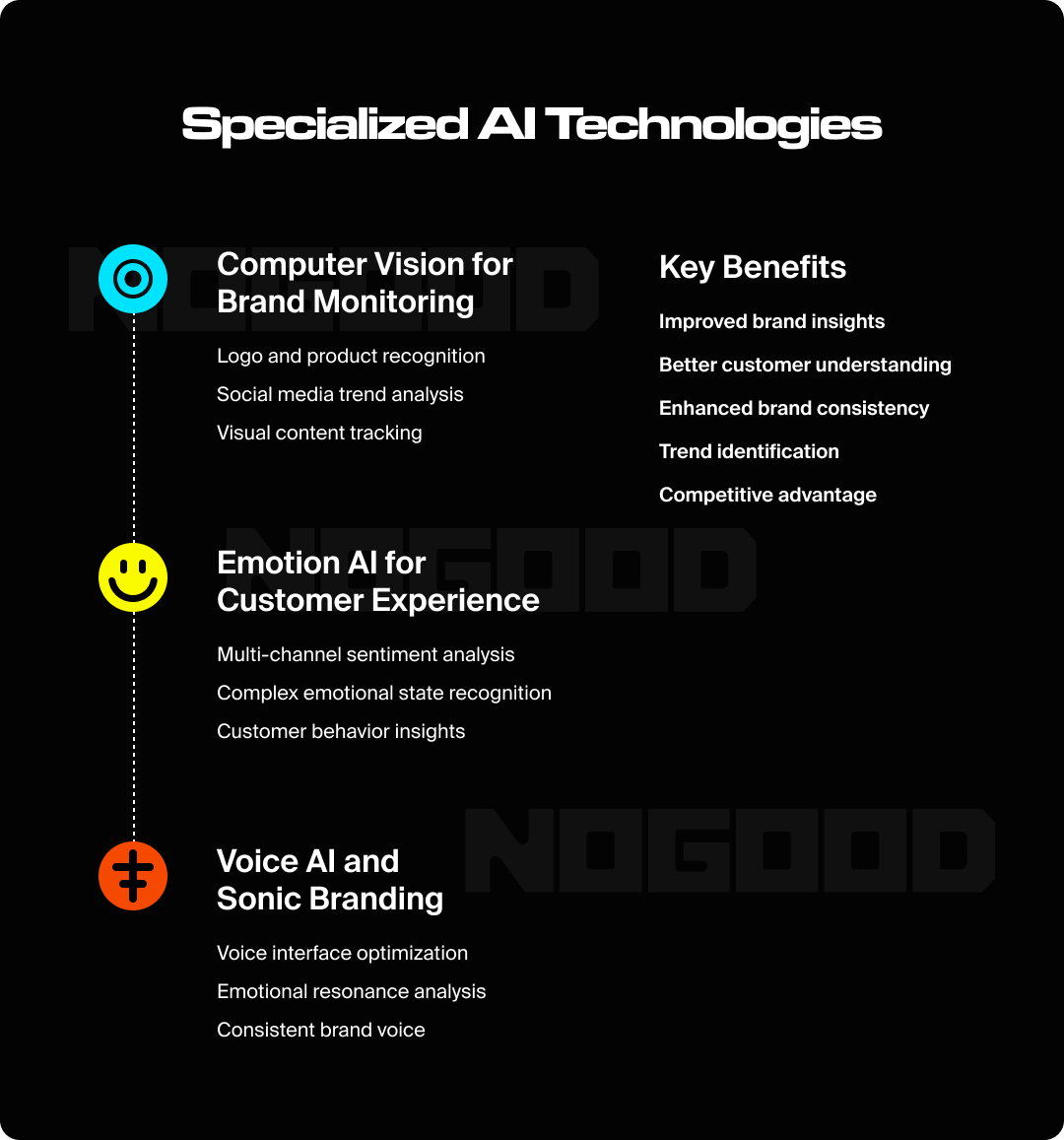As we enter 2025, we’re no longer predicting how AI will change marketing. Instead, it’s become clear how AI has already changed marketing for the future. Brands are connecting with their audiences using AI content, optimizing for AI search, and using AI to make employees more efficient.
AI Trends from 2024 → 2025
Remember when AI was just about scheduling social media posts and basic email automation? That’s no longer the case. In 2025, AI systems don’t just execute tasks but actively shape marketing strategy and drive creative decision-making. Marketers are leveraging AI, LLMs in particular, to become more efficient and enhance their creativity.
In 2024, there was a gap in research regarding the efficacy of LLMs for marketing tasks. To bridge that gap, NoGood conducted two LLM studies examining the quality of marketing tasks based on LLM: see our March 2024 blog summary for more information. These findings provide crucial insights for marketers by helping them make an informed decision about which LLM is best for their needs to continue optimizing their AI strategy in 2025.

Technology is evolving beyond basic automation into something more intuitive and powerful. As per Statista, over 37% of marketing teams have embraced AI as a core part of their strategy. Machine learning algorithms are sophisticated enough to understand context and nuance in customer interactions. Natural language processing (NLP) has evolved to generate human-like content that resonates with each audience segment. Computer vision technology can analyze visual content and understand brand preferences at a deep level. These advancements aren’t just incremental improvements; they represent a fundamental shift in how brands can connect with their audiences.
Emerging AI Marketing Trends to Look Out for in 2025
1. AI Agents: Your Marketing Side-Kick
Hello AI agents! An AI agent acts as both your assistant and your colleague. They aren’t a single AI tool; instead, they’re a collection of tools. This means no matter an employee’s position in a company, whether a manager or an associate, each individual will have a team of AI tools that can schedule meetings, brainstorm ideas, and become an extension of your available work tools.
Ever since ChatGPT became a household name, the tech community began hinting at the potential of AI becoming more than a chatbot and instead being an integral part of daily work. Throughout 2024, these tools quietly gathered steam, and in 2025, they’re set to become an essential pillar of marketing automation.
AI agents are the center of your department’s activities. Unlike chatbots and automation tools, these sophisticated systems are revolutionizing how we approach marketing operations. They can continuously process information across multiple channels, providing data-driven insights in real-time.
For example, popular CRMs like Hubspot are using AI tools to enhance marketers’ ability to interpret and present data. It also uses Content Assistant and ChatSpot to help personalize emails, craft social media posts, and manage customer relationships.
Internal systems respond to and anticipate customer needs, creating a seamless experience across channels. Agents can automatically adjust bidding strategies across advertising platforms, optimize email send times based on individual recipient behaviors, and customize website layouts for different visitor segments. The real power lies in their ability to learn and improve over time; every interaction and transaction adds to their understanding of what works for a consumer and what doesn’t.

AI agents can break down data siloes by sharing information across services. Data can be pulled directly from CRM systems, social media platforms, web analytics, and customer service interactions.
2. Hyper-Personalization
Personalization in 2025 is beyond adding someone’s first name to an email marketing campaign. AI personalization is about creating truly individualized experiences at scale. Imagine a physical advertising campaign that automatically adjusts digital displays based on products you’ve recently purchased.
This turns data from online purchases into real life advertisements. At the moment, this may seem far-fetched, but compare this to advertisements on social media. You’re already targeted based on your online persona. The next shift in hyper-personalization is for this to arrive in the material world.

Now apply this same concept to data-driven growth marketing campaigns. Instead of solely advertising through your digital profile (social media accounts), customers could receive mobile notifications with perfectly timed offers based on their daily routines.
Hyper-personalization is embraced by top brands like Nike’s revolutionary digital strategy where they’ve increased their e-commerce conversion rates by 35%. Their system analyzes customer behavior across multiple touchpoints – mobile apps, websites, and physical store visits to create hyper-personalized product recommendations and marketing messages.
Key results:
- 3x increase in mobile app engagement
- 28% reduction in ad spend waste
- 40% improvement in customer lifetime value
3. Answer Engine Optimization
What started in 2024 is more important than ever in 2025! Brand visibility across platforms is going to be difficult as everyone tries to understand how different algorithms prioritize and choose content. Unlike traditional search engines that return a list of blue links, answer engines provide direct and contextual responses to queries. This shift requires a new approach to optimization focusing on earned sources and owned sources.
Earned sources typically align to off-page efforts. The theme of earned sources is that they’re sources where brands want to build trust and a positive reputation. This reputation will improve positioning and encourage LLMs to trust your brand as a source of information.
Owned sources refer to when brands own their content. If content that is directly written and coordinated by a brand does not align with the brand voice and user intent, then the content will not be found on LLMs. This can decrease a brand’s visibility.
By optimizing and leveraging these two sources of information LLMs will have a better understanding of your brand and be more likely to include your content as a recommended source.
Developed content should also anticipate and answer user questions, providing context and establishing brands as experts in their fields. To be successful brands need a deep understanding of how these AI systems process and evaluate information. Content should be structured with clear hierarchies using schema markup and semantic HTML to help AI systems understand the relationships between different pieces of information.
Brands should prioritize positioning themselves across LLMs such as Perplexity, ChatGPT, and Gemini. By tailoring strategies to directly target each LLM brands will stay ahead of their competition.
4. Predictive Analytics
Data-driven insights informed by AI give a deeper understanding to complex reports and data. AI-powered systems process massive amounts of data from multiple sources, forecasting customer behavior, identifying emerging market opportunities, and anticipating shifts in consumer sentiment.
AI systems recognize patterns that would be near impossible for human analysts to spot through manual analytics. Market behavior is predicted through multiple factors instead of solely customer behavior. Strategy considers weather patterns, local events, and historical purchasing data. Analytics can operate in real time, allowing dynamic strategies that adapt as things change.
Tools to Try in 2025
1. Microsoft Power BI
This AI-powered business intelligence platform combines data visualization with advanced predictive modeling capabilities, enabling users to forecast trends and make data-driven decisions. The platform is valuable for marketing teams of all sizes, from small businesses to enterprise organizations, as it simplifies complex data analysis and automates reporting processes without requiring extensive technical expertise.
With its ability to provide real-time campaign tracking, enhanced targeting capabilities, and predictive analytics powered by AI, Power BI is emerging as a must-watch marketing technology that can help businesses stay competitive by turning their marketing data into actionable insights that drive better ROI.
2. Alteryx AI
This enterprise analytics solution combines generative AI capabilities with data analytics tools, enabling organizations to automate workflows and extract meaningful insights through natural language interactions with their data. The platform is valuable for enterprises seeking to democratize data analytics across their organization, as its AI-powered features like AiDIN Copilot make sophisticated data analysis accessible to both technical and non-technical users.
With its track record of significantly reducing time-to-insight for over 8,000 customers and its commitment to responsible AI development, Alteryx is positioned as a transformative technology that’s reshaping how businesses approach data analytics, making it especially relevant for organizations looking to build a more data-driven culture while maintaining enterprise-grade security and scalability.
3. Aaru – Lumen
This new company has been at the forefront of harnessing the power of AI to make predictions across the political sphere and the private sector. Their flagship model for the private sector, “Lumen,” configures audiences to predict customer persona behavior. Using a multi-agent approach, Aaru is truly thinking innovatively to create simulations based on events that haven’t yet happened. Although Aaru is a new company, it’s emerging as a must-watch in 2025 due to their innovative and technologically advanced approach to data.
5. Specialized AI Tech
While generative AI and LLMs grab headlines, specialized AI technologies are doing the real work. They are purpose-built AI systems designed to excel at particular tasks, often outperforming more general-purpose AI solutions.
Computer Vision for Brand Monitoring
Advanced computer vision AI can analyze visual content across social media, websites, and video platforms to track brand presence, monitor competitor activities, identify emerging trends, and track brand positioning. The technology recognizes logos, products, and brand elements even when they’re not explicitly tagged or mentioned in text.
With this technology, brands receive improved insights into their positioning and can leverage observations to improve their product and keep up with trends in the market. Computer vision also gives customers and brands insights into product placement and allows for direct purchasing even when brands aren’t explicitly mentioned.
Emotion AI for Customer Experience
Sophisticated emotion AI systems can analyze customer interactions across multiple channels to understand emotional responses and sentiment. This goes beyond simple positive/negative sentiment analysis to recognize complex emotional states and their implications for customer behavior.
Brands can utilize this information to better understand their customers’ personas. An improved understanding allows brands to speak to consumer needs instead of just reacting to positive and negative reactions to products.
Voice AI and Sonic Branding
As voice interfaces become more prevalent, specialized AI systems are helping brands develop and maintain consistent sonic branding across all touchpoints. These systems can analyze voice interactions for emotional resonance and brand consistency, while helping to create voice-optimized content. A more consistent brand image will improve the brand’s positioning and improve visibility towards customers.

Preparing for Success in 2025
Success in 2025 will belong to brands that can harness generative AI and AI marketing trends while maintaining an authentic connection with their audiences. The key is finding the right balance between automation and authenticity, between innovation and trust.
To best find that balance, marketers should understand two things about AI technology. First, AI tools can make your job easier and better. By using an AI agent, employees will feel empowered to make their own decisions and be more efficient with their time by delegating tasks to AI instead of taking them on themselves. Secondly, brands that harness AI through predictive analytics and specialized AI tech will be in a better position to connect with their consumers.
Taking Action in 2025
- Evaluate your current AI capabilities – Do you currently use AI? If so, how? Are all employees utilizing AI to the best of its ability?
- Identify areas where AI can add the most value – Would it be valuable for your company to create an AI agent protocol? Does this mean your tech stack always includes AI, and if so, how is this implemented?
- Develop a clear implementation strategy – Does everyone have the same tech stack available to them? Do certain team members need access to different tools?
- Train your team on new AI tools and approaches and implement them into your standard operating procedures.
At NoGood, we are pioneers of AI using new technology to be more efficient and provide our customers with an AI optimized experience.






